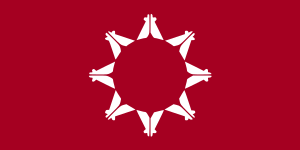More languages
More actions

The Lakota (Lakȟóta) are a nation in the Great Plains of North America. They include seven tribes or bands and are part of the Sioux along with the Dakota.
History[edit | edit source]
Early history[edit | edit source]
Colonization[edit | edit source]

The Lakota and the United States established treaties in 1805, 1815 and 1825. In the early 19th century, the Lakota became dependent on horses, guns, tools, and other items from settlers. They abandoned farming and relied completely on bison hunting, increasing their dependence on weapons and ammunition from settlers.[1]
In the 1830s, the Rocky Mountain Fur Company caused the Lakota to move south from the Upper Missouri to Upper Platte region near Fort Laramie. The 1851 Treaty of Fort Laramie reduced Lakota sovereignty and ceded a large amount of territory to the United States. After being weakened by starvation, disease, and attacks on their villages, the Lakota signed another treaty at Fort Laramie in 1868, making them dependent on the U.S. government for food and rations. The U.S. government ensured their dependence by exterminating the buffalo between 1870 and 1876.
In 1876, after Custer's Seventh Cavalry discovered gold, the United States seized the Black Hills, which was reserved to the Sioux by the 1868 treaty.[1] Crazy Horse (Tȟašúŋke Witkó) and Sitting Bull (Tȟatȟáŋka Íyotake) formed an alliance with the Cheyenne and destroyed the settler army at the Battle of Little Bighorn, but the settlers killed Crazy Horse a year later.[2] After the Lakota surrendered in 1877, they also lost the area around the Powder River, and the U.S. army drove them out of Nebraska in the same year.
In 1888, a government commission arrived in Sioux territory with a proposal to reduce their land to six small reservations and open nine million acres to settlers. The commission failed to receive signatures from three-quarters of Sioux men, so they returned and forced the Sioux to sell their land for $1.50 per acre.[1] After the murder of Sitting Bull, Spotted Elk (Si Tȟáŋka) led hundreds of refugees to the Pine Ridge Reservation to surrender. When they arrived on December 29, 1890, U.S. soldiers massacred 300 defenseless Lakotas at Wounded Knee.[2] By the 1920s, settler ranchers had occupied almost all of the best grazing lands.[1]
American Indian Movement[edit | edit source]
On February 27, 1973, the American Indian Movement sent a caravan of hundreds of people to liberate the Pine Ridge Reservation from the rule of the corrupt FBI-backed comprador Dick Wilson. Within hours, the FBI and Pentagon began a siege with armored tanks and .50-caliber machine guns. AIM held out for 71 days while relying on supplies from many native nations and other activists. After the end of the siege, Wilson's police assassinated more than 60 people. In 1975, the FBI framed Leonard Peltier for the death of two FBI agents on the reservation, and he has been in prison for over 40 years.[3]
References[edit | edit source]
- ↑ 1.0 1.1 1.2 1.3 Roxanne Dunbar-Ortiz (2014). An Indigenous Peoples' History of the United States: 'Ghost Dance Prophecy' (pp. 186–189). [PDF] Boston, Massachusetts: Beacon Press. ISBN 9780807000403
- ↑ 2.0 2.1 Roxanne Dunbar-Ortiz (2014). An Indigenous Peoples' History of the United States: '"Indian Country"' (pp. 151–5). [PDF] Boston, Massachusetts: Beacon Press. ISBN 9780807000403
- ↑ Gloria La Riva (2017-10-31). "People’s hero, AIM founder Dennis Banks 1937-2017" Liberation News. Archived from the original on 2022-11-29. Retrieved 2023-01-14.
